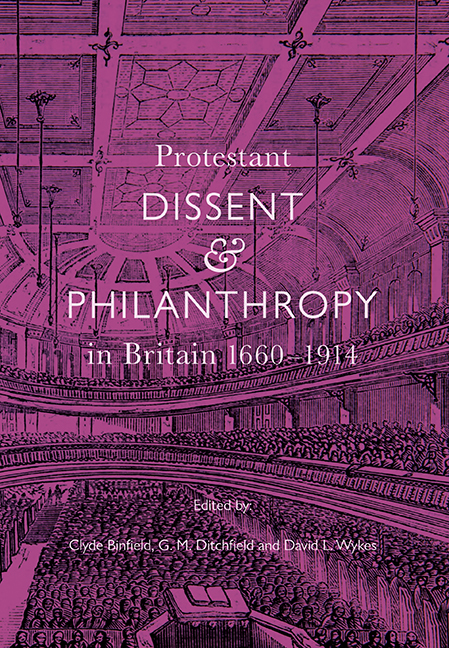Book contents
- Frontmatter
- Dedidcation
- Contents
- List of Illustrations and Tables
- List of Contributors
- Acknowledgements
- List of Abbreviations
- Introduction
- 1 Dissent and Charity, 1660–1720
- 2 Dissenters and Charity Sermons, c. 1700 to 1750
- 3 John Howard, Dissent and the Early Years of Philanthropy in Britain
- 4 Rational Philanthropy: Theory and Practice in the Emergence of British Unitarianism, c. 1750–1820
- 5 David Nasmith (1799–1839), Philanthropy Expressed as Campaigning
- 6 Building Philanthropy: The Example of Joshua Wilson (1795–1874)
- 7 Funding Faith: Early Victorian Wesleyan Philanthropy
- 8 Unitarians and Philanthropy After 1844: the Formation of a Denominational Identity
- 9 Children and Orphans: Some Nonconformist Responses to the Vulnerable in Victorian Britain
- 10 The Rowntree Family and the Evolution of Quaker Philanthropy, c. 1880 to c. 1920
- 11 ‘Not slothful in business’: Enriqueta Rylands and the John Rylands Library
- Select Bibliography
- Index
- STUDIES IN MODERN BRITISH RELIGIOUS HISTORY
9 - Children and Orphans: Some Nonconformist Responses to the Vulnerable in Victorian Britain
Published online by Cambridge University Press: 21 March 2020
- Frontmatter
- Dedidcation
- Contents
- List of Illustrations and Tables
- List of Contributors
- Acknowledgements
- List of Abbreviations
- Introduction
- 1 Dissent and Charity, 1660–1720
- 2 Dissenters and Charity Sermons, c. 1700 to 1750
- 3 John Howard, Dissent and the Early Years of Philanthropy in Britain
- 4 Rational Philanthropy: Theory and Practice in the Emergence of British Unitarianism, c. 1750–1820
- 5 David Nasmith (1799–1839), Philanthropy Expressed as Campaigning
- 6 Building Philanthropy: The Example of Joshua Wilson (1795–1874)
- 7 Funding Faith: Early Victorian Wesleyan Philanthropy
- 8 Unitarians and Philanthropy After 1844: the Formation of a Denominational Identity
- 9 Children and Orphans: Some Nonconformist Responses to the Vulnerable in Victorian Britain
- 10 The Rowntree Family and the Evolution of Quaker Philanthropy, c. 1880 to c. 1920
- 11 ‘Not slothful in business’: Enriqueta Rylands and the John Rylands Library
- Select Bibliography
- Index
- STUDIES IN MODERN BRITISH RELIGIOUS HISTORY
Summary
Introduction
Two things were evident to Victorian Nonconformists: the Scriptural imperative to care for orphans was clear and the demands of the times were pressing. Britain was moving from a range of small-scale familiar communities to an anonymous world born of the machine, compounded in large towns where agencies of support became less certain as families dispersed and friends and neighbours shared in the distress of society's lower orders. The deterrent emphasis of the New Poor Law (1834) on the strict regime of the less-eligible workhouse bore increasingly on Christian consciences to produce a more compassionate remedy for youthful destitution. As a matter of strict law, conditions of less eligibility were not applicable to children but in the public mind the workhouse cast its shadow widely and the involvement of Dissenters in enterprises to remedy such destitution testifies to their increased wealth, their awareness of the unequal spread of fortune, and the obligations thus laid upon the more affluent to deploy their abundance to the advantage of the poor. In this category ‘Street Arabs’, though not perhaps technically orphans, were amongst the most deserving of uncared-for children: in 1876 thirty thousand of them under the age of sixteen were to be found, according to Thomas Barnardo, on the streets of London alone.
All religious groups made some provision for the care of orphans, seeking to combine material relief with spiritual advantage. The Roman Catholic Church, concerned for its faithful in a fiercely Protestant world, early had a major presence, establishing institutions largely staffed by nuns. Some Anglican institutions were also staffed by women in religious orders but the homes of the Waifs and Strays Society (1881; later known as the Church of England Children’s Society), which was regarded in popular estimation as one of the ‘big three’ in orphanage provision, alongside Barnardo's and the National Children’s Homes, were mainly staffed by lay people. These institutions were relatively late on the orphanage scene, drawing in organisation and public esteem on the influence of two earlier enterprises. One was the famous Foundling Hospital (1739), pioneered in London by Thomas Coram (1668–1751); the other was the Ragged School movement, a weekday complement to Sunday schools, focused on the neediest children, coming together in the Ragged School Union (1844) and exemplified by the work of Thomas Cranfield (1758–1838), a journeyman tailor associated with Southwark's Surrey Chapel.
- Type
- Chapter
- Information
- Protestant Dissent and Philanthropy in Britain, 1660–1914 , pp. 169 - 186Publisher: Boydell & BrewerPrint publication year: 2020



